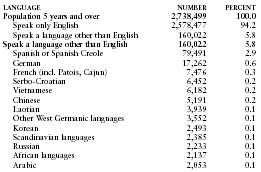Iowa
Languages
A few Indian place-names are the legacy of early Siouan Iowa Indians and the westward-moving Algonkian Sauk and Fox tribes who pushed them out: Iowa, Ottumwa, Keokuk, Sioux City, Oskaloosa, Decorah.
Iowa English reflects the three major migration streams: Northern in that half of the state above Des Moines and North Midland in the southern half, with a slight South Midland trace in the extreme southeastern corner. Although some Midland features extend into upper Iowa, rather sharp contrasts exist between the two halves. In pronunciation, Northern features contrast directly with Midland: /hyumor/ with /yumor/, /ah/ in on and fog with /aw/, the vowel of but in bulge with the vowel of put, and /too/ with / tyoo/ for two . Northern words also contrast with Midland words: crab with crawdad, corn on the cob with roasting ears, quarter to with quarter till, barnyard with barn lot, and gopher with ground squirrel .
In 2000, 94.2% of all Iowans aged five or more spoke only English at home, down from 96.1% in 1990.
The following table gives selected statistics from the 2000 census for language spoken at home by persons five years old and over. The category "Other West Germanic languages" includes Dutch, Pennsylvania Dutch, and Afrikaans. The category "African languages" includes Amharic, Ibo, Twi, Yoruba, Bantu, Swahili, and Somali. The category "Scandinavian languages" includes Danish, Norwegian, and Swedish.

| LANGUAGE | NUMBER | PERCENT |
| Population 5 years and over | 2,738,499 | 100.0 |
| Speak only English | 2,578,477 | 94.2 |
| Speak a language other than English | 160,022 | 5.8 |
| Speak a language other than English | 160,022 | 5.8 |
| Spanish or Spanish Creole | 79,491 | 2.9 |
| German | 17,262 | 0.6 |
| French (incl. Patois, Cajun) | 7,476 | 0.3 |
| Serbo-Croatian | 6,452 | 0.2 |
| Vietnamese | 6,182 | 0.2 |
| Chinese | 5,191 | 0.2 |
| Laotian | 3,939 | 0.1 |
| Other West Germanic languages | 3,552 | 0.1 |
| Korean | 2,493 | 0.1 |
| Scandinavian languages | 2,385 | 0.1 |
| Russian | 2,233 | 0.1 |
| African languages | 2,137 | 0.1 |
| Arabic | 2,053 | 0.1 |